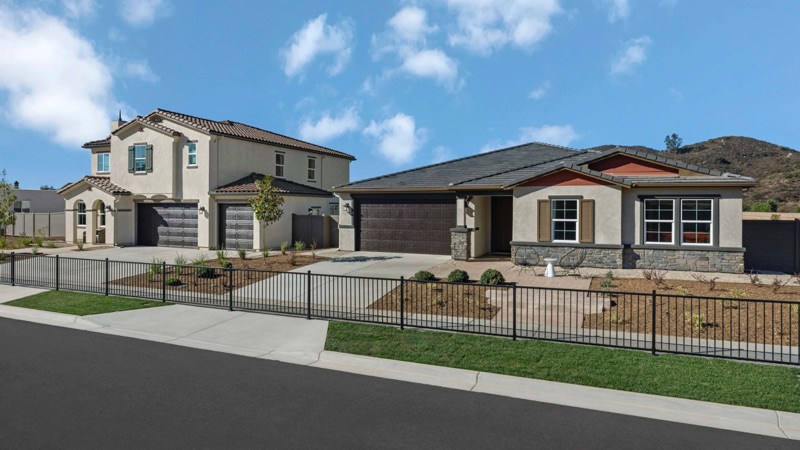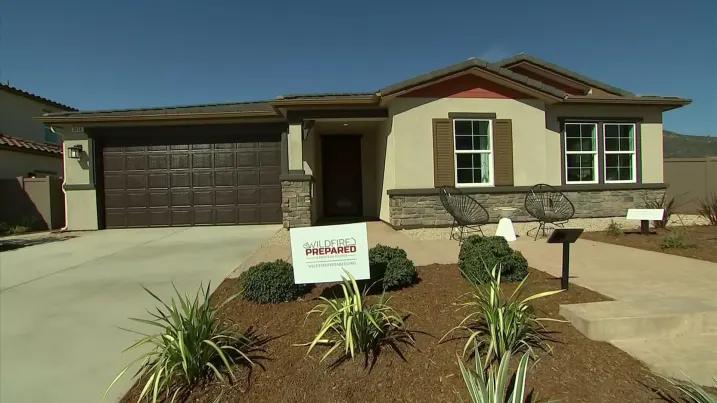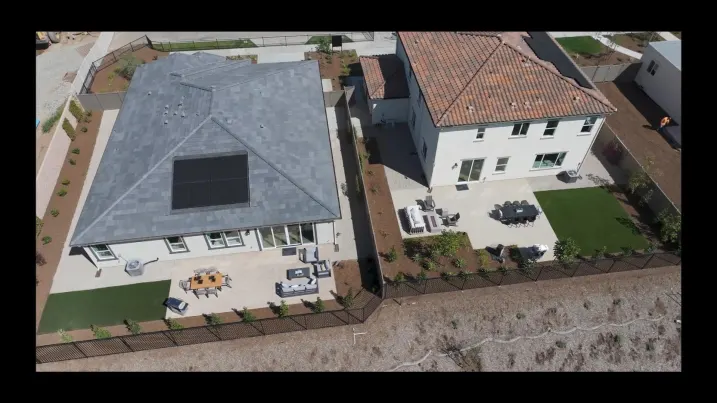Wildfire-Resilient Development: KB Home’s Dixon Trail Sets a New Standard for Resilient Communities

KB Home’s Dixon Trail in Escondido, CA, is the nation’s first community built to the Insurance Institute for Business & Home Safety’s new Wildfire Prepared Neighborhood standard, showcasing fire-resilient home design.
KB Home has unveiled a first-of-its-kind wildfire-resilient community in Escondido, California. The Dixon Trail development – an enclave of 64 single-family homes starting from just over $1 million – is the first neighborhood in the nation designed to meet the Wildfire Prepared Home™ Plus and Wildfire Prepared Neighborhood standards developed by the Insurance Institute for Business & Home Safety (IBHS) . This achievement underscores KB Home’s innovation and leadership in climate resilience, marking a new benchmark for real estate developers and investors concerned with risk mitigation and long-term value. By leveraging IBHS’s research-backed strategies, KB Home is proactively addressing the growing threat of wildfires in the West and setting an example of how to build safer, more insurable communities without sacrificing marketability or quality.
Pioneering a Wildfire Prepared Neighborhood

In keeping with its history of industry firsts, KB Home’s Dixon Trail community is the first applied use of IBHS’s new Wildfire Prepared Neighborhood standard . Each home in Dixon Trail is built to the Wildfire Prepared Home™ Plus designation – IBHS’s highest tier for individual home wildfire mitigation . At the same time, the entire neighborhood’s layout and infrastructure have been engineered to reduce fire risk at a community scale . “In keeping with our tradition of innovation, we are pleased to offer today’s buyers the ability to choose a wildfire-resilient home and community. We are proud that our new Dixon Trail community, with its system of mitigation features, is the first in the nation to meet IBHS’s wildfire resilience standards at the homesite level and at the neighborhood level,” said Jeffrey Mezger, Chairman and CEO of KB Home .
Achieving the Wildfire Prepared Neighborhood status means implementing preventative measures not just per house, but across property lines. Dixon Trail received a provisional neighborhood-level designation upon launch, confirming that its design will reduce the chances of ignition from an approaching wildfire, defend against wind-blown embers, and slow any fire that might start . Once all homes are completed and an IBHS evaluation is passed, Dixon Trail will earn the final Wildfire Prepared Neighborhood certification – officially making it a model of wildfire-resilient development in the U.S. real estate market.
Fire-Resilient Construction: Features and Specifications

What makes Dixon Trail truly stand out is the suite of technical wildfire-mitigation features built into each home and the neighborhood. Every home in the community incorporates design elements proven to resist flames and embers . Key fire-resilient features include:
• Class A fire-rated roofing – highly fire-resistant roof materials that can withstand direct flame exposure .
• Noncombustible exteriors and siding – fireproof exterior walls (fiber-cement siding and stucco) that won’t ignite, with at least 6 inches of clearance from the ground to avoid vegetation catching the siding .
• Ember- and flame-resistant attic vents – specially designed vents to block burning embers from entering attics, a common ignition point for homes .
• Upgraded tempered-glass windows and fire-rated doors – multi-pane windows with tempered glass that resist shattering from heat , and exterior doors made of noncombustible materials. These prevent break-ins by flames and embers at vulnerable openings.
• Noncombustible gutters and soffits – metal gutter systems (often with gutter guards) that won’t ignite and enclosed eaves/soffits to eliminate exposed wood surfaces . This stops debris or embers from igniting the roof edges.
• 5-foot defensible space buffer – a noncombustible zone immediately around each house with no flammable landscaping or fencing . This buffer (essentially a cleared or hardscaped Home Ignition Zone) greatly reduces the chance of flames touching the structure.
• All-metal fencing and fire-resistant landscaping – any fences are metal and no wooden fences attach to homes, removing a typical wildfire “wick.” Drought-tolerant, ignition-resistant plants and hardscape features are used to minimize fuel near structures .
• Generous spacing between homes – nearly all houses are separated by more than 10 feet from any neighboring structure . This spacing, combined with fuel breaks in the landscaping, helps prevent fire from jumping from house to house.
By integrating these elements, Dixon Trail homes are built to withstand direct flame contact, intense radiant heat, and showers of embers – the primary wildfire threats . For example, Class A roofs and tempered windows guard against wind-driven embers that could otherwise penetrate and ignite a home’s interior. The 5-foot perimeter of gravel or hardscape ensures no mulch, brush, or wood touches the homes. As IBHS CEO Roy Wright explains, “With fire becoming an increasingly common threat in the West, it’s crucial to reconsider how we construct communities in fire-prone regions. KB Home is at the forefront, implementing our research-driven wildfire mitigation strategies for both the parcel and neighborhood levels at Dixon Trail.” The result is a community engineered holistically for fire defense – from roofing to siding to the spacing of the lots.
Risk Mitigation and Insurance Implications

The significance of Dixon Trail goes beyond construction—it represents a new approach to risk mitigation in residential development. Wildfire risk has become a critical issue for the real estate industry in California and other western states. In recent years, insurance companies have been retreating from high-risk fire zones, cancelling policies or refusing new coverage due to mounting wildfire losses . This insurance strain has even led to government intervention; for instance, California’s FAIR Plan (the insurer of last resort) has seen surging enrollment, and regulators imposed moratoria on policy cancellations after major fires . For developers and investors, the inability of homebuyers to obtain or afford insurance represents a serious business risk, potentially stalling projects or depressing property values.
Wildfire-resilient communities like Dixon Trail offer a path forward on this insurance challenge . By meaningfully reducing the likelihood of catastrophic fire spread, these homes are expected to be more insurable and potentially eligible for better rates. As one IBHS expert noted, “We know what happens when vulnerable communities don’t do the mitigation… But when they do, homes become more insurable. They stand a chance. And people have a home to return to.” In fact, early evidence shows hardened homes survive wildfires at much higher rates than others – one study found homes built to modern wildfire-resistant codes were 40% less likely to be destroyed compared to older homes .
Regulators and insurers are taking note. California recently implemented a program requiring insurers to offer discounts for certain wildfire mitigation measures . While initial discounts (only ~0.1% off premiums for something like installing tempered windows) have been modest , the move signals that future insurance pricing will favor resilient construction. More importantly, without hardened features, homes in fire zones may simply become uninsurable at any price – a risk no investor or homeowner wants. By building to the IBHS standard, KB Home is essentially future-proofing the insurability of these properties. From an insurance perspective, Dixon Trail serves as a case study that proactive mitigation can keep insurance available and mitigate skyrocketing premiums in fire-prone markets .
The Investment Case for Resilience
Beyond safety and insurance, Dixon Trail highlights the value proposition of resilience features for developers and investors. One might assume that building to such high wildfire-resistant specs significantly increases construction costs. However, studies indicate that enhancing a new home’s wildfire resistance adds only a modest amount to construction costs – on the order of just 2% to 13% extra in California, much of which is offset by long-term savings . As IBHS’s Roy Wright put it, “a lot of these actions have fairly negligible cost… That’s the kind of investment that’s assuredly going to pay off if a wildfire approaches a community.” In Dixon Trail’s case, the starting prices in the ~$1 million range suggest that the market is willing to absorb the cost of these upgrades, especially given the location and the peace of mind they provide.
From an investor’s perspective, resilient design can be a selling point and a competitive advantage. Homebuyers are increasingly aware of climate-related risks and may gravitate toward homes that offer better protection (and fewer nightmares about losing everything to fire). Moreover, properties built to higher resilience standards may hold value better over time, as they’re less likely to suffer total loss in a disaster. There’s also a potential marketing and branding upside: KB Home is demonstrating corporate responsibility and foresight, which can enhance its reputation among consumers, regulators, and capital partners. In a sector where environmental, social, and governance (ESG) factors are gaining attention, proactive risk mitigation is a strong ESG selling point.
Daniel Kaufman, a Los Angeles-based real estate advisor and investor, emphasizes that Dixon Trail is a glimpse into the future of development. “Wildfire-resistant design isn’t just a safety upgrade – it’s an investment in the longevity and stability of a community,” Kaufman says. “Developers and investors who integrate resilience are protecting their assets and their buyers. In high-risk regions, a neighborhood like Dixon Trail can mean the difference between a thriving community and a stranded one. I expect wildfire-resistant communities will command a premium and become the norm as we adapt to climate realities.” This perspective underlines that resilience features add tangible value: they reduce the probability of costly losses, ensure insurance availability, and appeal to a market looking for long-term security in their real estate investments.
Future Outlook: Resilience as the New Norm in Development
The Dixon Trail project is not intended to be a one-off anomaly – it’s a proof of concept for scalable wildfire-safe communities. IBHS’s Wildfire Prepared Home and Neighborhood programs are already being piloted beyond California, including projects in Oregon, and multiple builders have expressed interest in adopting similar standards . KB Home itself signals that Dixon Trail is just the beginning. The lessons learned in Escondido – from design adjustments to supply chain coordination for fire-rated materials – can be applied to future developments in other fire-prone areas. Company leaders have indicated that they view resilience as a continuation of KB’s long-running innovation arc, not a niche experiment . “This is just the next step. We’re looking at homes that are safer, more energy- and water-efficient, and resilient. That’s not a checklist – it’s a responsibility,” says Jacob Atalla, KB Home’s VP of Sustainability, reflecting on how wildfire resilience fits alongside the builder’s achievements in energy efficiency and sustainable design .
For real estate developers and investors, the emergence of wildfire-resilient communities like Dixon Trail is a bellwether for a broader trend. As climate-driven disasters (wildfires, hurricanes, floods) continue to pose material threats to real estate assets, incorporating resilience into new construction is moving from optional to essential. Forward-thinking builders are finding ways to do this while still maintaining profitability and appealing design – effectively fusing resilience, affordability, and innovation . There may have been a perception that making homes more disaster-resistant would price them out of the market, but KB Home’s success suggests that buyers will pay for peace of mind, and that builders can integrate these features cost-effectively.
Looking ahead, we can expect more projects like Dixon Trail. KB Home is already exploring additional neighborhoods with fire-hardening measures as part of its product offerings (the company’s official listing for Dixon Trail touts “wildfire prepared neighborhood” status as a selling point , hinting at a marketing strategy that could extend to other communities). Meanwhile, other major homebuilders and local developers are watching closely. Dixon Trail is a signal, not just a case study – it demonstrates to the industry that building to a higher resilience standard is feasible and can be embraced by the market. As more jurisdictions update fire hazard maps and building codes to require safer construction , those developers who get ahead of the curve stand to benefit. They will face fewer surprises in insurance and regulatory compliance, and they’ll build goodwill with increasingly climate-conscious buyers.
KB Home’s wildfire-resilient Dixon Trail development represents a milestone in climate-conscious real estate development. It showcases how innovative design and collaboration with scientific research (via IBHS) can reduce risk in tangible ways. For investors, it offers a template for protecting investments against natural disasters. For insurers, it’s a potential model that could reduce huge loss payouts. And for communities, it offers hope that living in beautiful yet fire-prone regions can be made safer and more sustainable. The price point – homes starting around $1.0 million – reflects both the premium location and the value of the hardening features, reinforcing that resilience has a real market value. As wildfire seasons grow longer and more intense, the Dixon Trail approach may well become a standard expectation. In the words of Daniel Kaufman, “we must rebuild smarter, with a focus on resilience, because the stakes have never been higher” . Dixon Trail is a compelling example of what rebuilding smarter can look like – and why it matters for those building and investing in the communities of tomorrow.
Sources:
• KB Home Press Release – “KB Home Introduces Wildfire-Resilient Neighborhood”
• The Builder’s Daily – “Fire-Ready Future Forward: KB Home Builds Hardened Homes at Scale”
• Insurance Institute for Business & Home Safety (IBHS) – Wildfire Prepared Home™ Program Guidelines
• NPR – “Fireproofing your home isn’t very expensive — but few states require it”
• Daniel Kaufman Real Estate Blog – “Impact of Los Angeles Wildfires on Housing and Insurance Markets” (context on insurance market challenges)
• HBS Dealer – “KB Home unveils ‘wildfire-resistant’ community” (coverage of Dixon Trail features and quotes)
Comments
Post a Comment